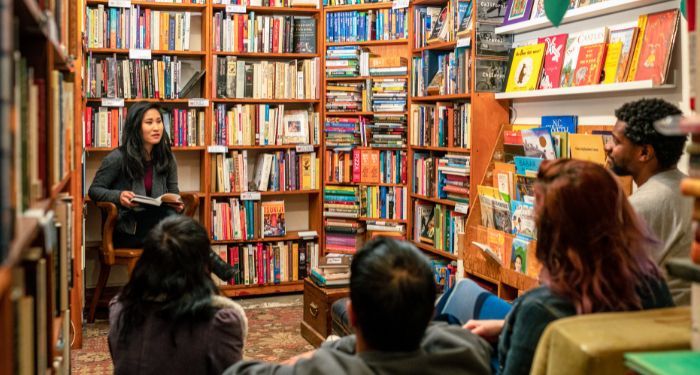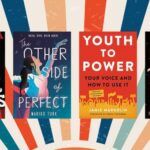
The Importance of Book-Centered Spaces as Third Places
“Sometimes you want to go where everybody knows your name.” Those are some of the most popular TV theme show lyrics of all time, the beloved anthem of the 1980s hit Cheers. They’re also often used when describing a “third place,” a sociological concept that’s become popular in everything from psychology to city planning. Third places are essential parts of communities where people go to have fun, build relationships with neighbors, and share information. And some of the most valuable, loved, and dynamic third places are book-centric. Libraries and bookstores are often thought of as locations where readers can acquire books. But considering them through the lens of a third place can show just how dynamic and crucial they are to the communities they serve.
What Are Third Places?
The concept of third places was first introduced by urban sociologist Ray Oldenburg in his 1989 book The Great Good Place. According to Oldenburg, “first places” are the homes where we live, “second places” are where we work or study, and “third places” are the informal, neutral gathering spaces where we can spend our free time. They are public places where people go to enjoy themselves and meet others in their community. Third places can look like neighborhood bars and cafés, public parks, religious centers, community centers, and, of course, bookish places like libraries, bookstores, and writing centers. Access to these kinds of spaces is crucial for mental health, building meaningful relationships, and creating ties to community. They are, in many ways, the lifeblood of neighborhoods.
Even before the pandemic, academics, health professionals, and city planners were ringing alarms about the disappearance of third places and the damage this could do to individuals and cities. Third places have increasingly moved online to various messaging and social media platforms. While this has made it easier to connect with people across the globe, so much is lost when it comes to face-to-face communication and building networks within your actual physical neighborhood. This became an even greater concern after 2020, when the Covid pandemic caused many small businesses to shutter and vastly limited access to in-person public spaces. We still haven’t regained many of the third places we lost, although we’re beginning to see a resurgence.
Bookish third places, however, have fought through the pandemic and are now fighting against a wave of book bans threatening library funding and even lawsuits against bookstores for carrying books a vocal minority have deemed “obscene”. In addition to their work curating collections and putting books in the hands of readers, they’re offering room to build community, host fascinating conversations, and find a home away from home. And they’re doing it for some of the folks who most often struggle to find a welcoming third place: bookish introverts. Books can serve as a private escape from the rest of the world, but they can also be an entry point for conversations and meeting new people.
In his work, Oldenburg established eight conditions that define a third place. These conditions make it clear just how crucial book-centric spaces are as centers for fostering community and self-exploration.
1. Neutral Ground
Third places are meant to be a “neutral ground,” where participants are free to come and go at will without any formal obligation to be there. While they aren’t necessarily required to be open to the public, they must be fairly open and available to their audience. Bookstores and libraries go above and beyond on this metric, opening their doors to anyone for a variety of purposes. They serve as neutral meeting places for book clubs and events, for book lovers to browse and ask for recommendations, and for reading and enjoying books for all ages. Libraries also provide an enormous range of services like children’s entertainment, workforce development, research assistance, and so much more.
2. A Leveling Place
An important aspect of third places is their ability to place people of all socioeconomic classes and backgrounds on the same level. Social hierarchies create barriers in third places, and exclusion based on status can ruin the culture of inclusion that allows for dynamic conversations. A library is a great example of this, where all are welcome and included regardless of social standing. Bookstores and writing centers also offer a place for people of all backgrounds to join the literary conversation.
I vividly remember the first time I spoke to a high-profile author about my own writing at a bookstore event. Although I didn’t bring up writing and was there as a fan of the author’s work, she asked me if I wrote as well. I shyly admitted that, yes, I had a manuscript and had recently started querying agents. The author was incredibly supportive and made me feel like my writing was worthy of pride. It was a pivotal moment for me in learning to value my own work and in seeing authors as normal people, off of the publishing pedestal.
3. Space for Conversation
While third places can involve a wide variety of activities — shopping, dining, watching performances — they must also include dynamic conversations. Rather than being strictly centered around observing or listening, people must be able to get involved and talk with people in their community they might not otherwise encounter. My favorite place to have interesting conversations on a wide variety of topics? Bookish spaces, obviously. I’ve made dear friends at happy hours, book clubs, and author events. I’ve had a chance to talk about everything from writing craft to pop culture to outer space. If you’re an avid reader, you’re sure to find something to talk about with other patrons while visiting your local library or bookstore.
4. Accessibility & Accommodations
Back in the 1980s, Ray Oldenburg defined third places as accessible to their participants and accommodating of their needs. Our understanding of accessibility has grown immensely thanks to the advocacy of people with disabilities. Rather than simply meaning third places have reasonable hours and make it easy to get involved, we now know they must be thoughtful and intentional in their accessibility for people with physical and mental disabilities. Libraries have often been some of the first places to provide support and intentional inclusion for disabled people in their communities. Many bookstores are also putting a focus on accessibility and ways to better serve their disabled customers because books — and bookish spaces — are for everyone.
5. The “Regulars”
Another quality of a third place is the existence of “regulars” who help set the tone and create a welcoming environment for new visitors. These people play an important role in establishing the culture of a third place. And I can tell you from personal experience that there’s no better place to be a regular than your local indie bookstore. I love walking into my neighborhood bookstore and catching up with the booksellers I’ve known for years, who also always have a book recommendation specifically for me. Along with that, I feel a responsibility to add to the positive energy at bookstore events and strike up a conversation with anyone who looks nervous to jump into the group. I both benefit from the community at my local bookstore and I help build it. This kind of reciprocal relationship is part of the magic of third places.
6. Low Profile
Third places don’t have to be trendy or grandiose. In fact, it’s better if they’re not. Oldenburg theorized that community spaces are more welcoming and inclusive if they’re a little homely and lived in. While I love a glamorous bookstore or a state-of-the-art library, it’s true that I don’t feel as comfortable settling in and staying there for a spell. The bookish spaces that make the best third places are the ones that are quirky, functional, and designed with their community’s needs in mind.
7. Playful Mood
One of the most important defining characteristics of a third place? It has to be fun. After all, what kind of community can be built at a place where people don’t enjoy spending time? While third places can be the site of heavy, difficult, and perspective-shifting conversations, they must also involve playfulness, entertainment, and joy. It’s the crafting classes and Drag Story Hours and fun-filled book clubs that keep people coming back to book-centric spaces just as much — if not more than — the serious author talks and educational workshops.
8. Home Away From Home
Finally, third places are recognizable as a home away from home for their visitors. They are the cafés where you want to hang around chatting far past your last sip of coffee, the public parks where you can spend hours playing games with friends, the libraries where you can curl up with a book and finish it in one sitting. How many times have I said that my favorite bookstore is my second home? And I mean it. It’s where I go when I want to see a friendly face or brighten up a bad day with a new book. And for introverted readers who may struggle to find a place to feel like themselves outside of their home, libraries and bookstores can be just the familiar setting they need to find their place in their community.
Bookstores are so much more than places to buy a new novel. Libraries are so much more than their collections. Writing centers are so much more than a room to get work done. Book-centric places are always about more than the books. They are centers for community, spaces for learning and deep conversation, room for joy and play, homes away from home. If you’re a lover of books, think of your local bookish spaces as third places where you can grow as a person and put down roots in your neighborhood. Keep showing up, and you might just become a regular.
We hope this article showed you a new side of your favorite book-centric spaces! You might also enjoy:
35 of the Best Bookstores in the U.S.A.
What Will the Bookstore of the Future Look Like?
11+ Things U.S. Public Libraries Offer That You May Not Know About







